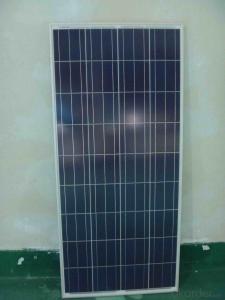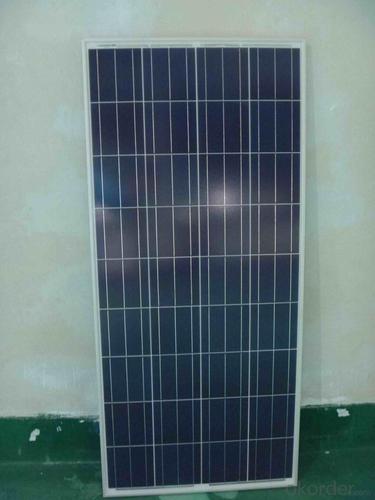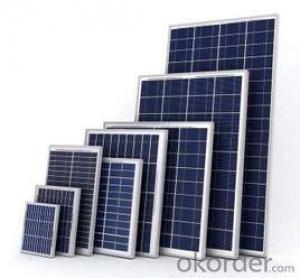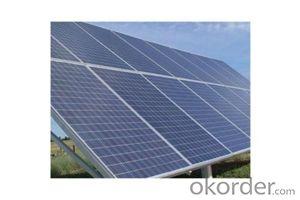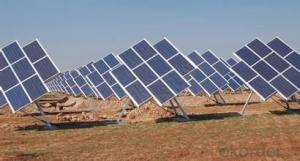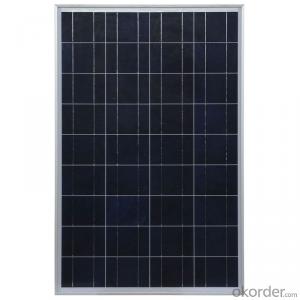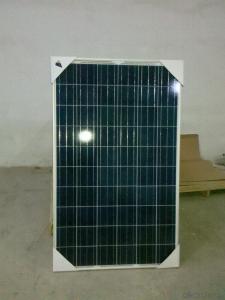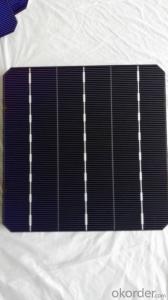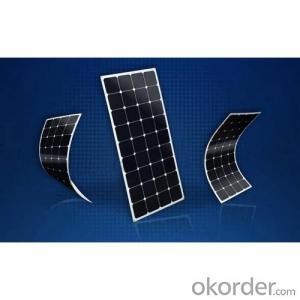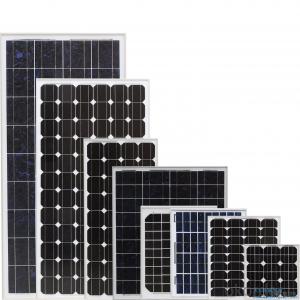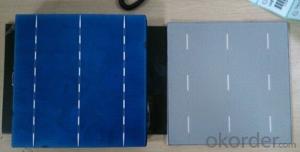156*156mm 150w Pb Solar Panels - China Polycrystalline Solar Panel
- Loading Port:
- Shanghai
- Payment Terms:
- TT OR LC
- Min Order Qty:
- 10000 watt
- Supply Capability:
- 1000000 watt/month
OKorder Service Pledge
OKorder Financial Service
You Might Also Like
Specification
Product Description
156*156mm 150W Polycrystalline Solar panel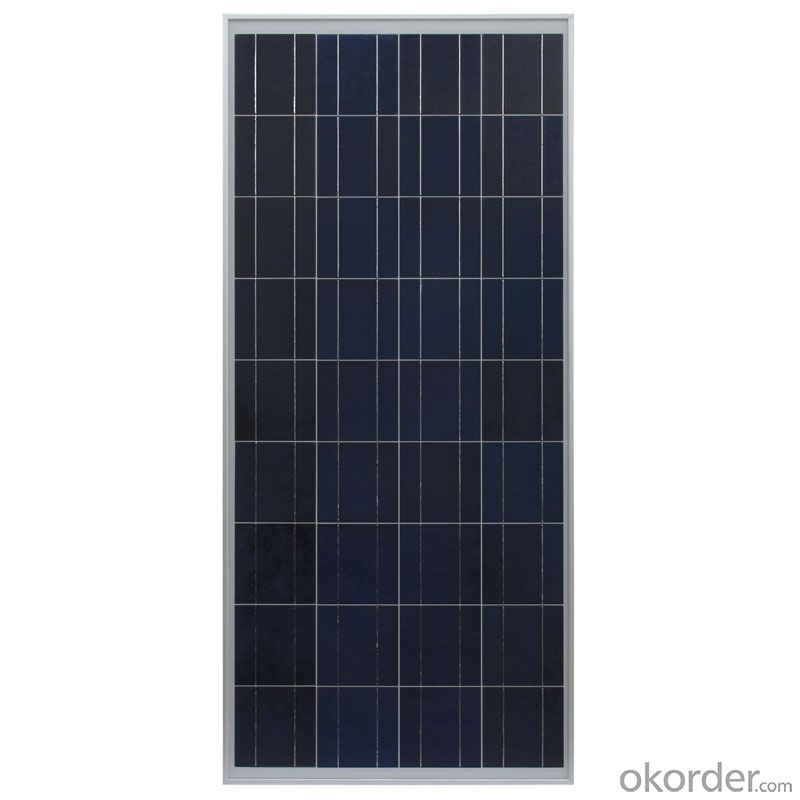 Quick Details:
Quick Details:
Place of Origin: Hebei China (Mainland)
Material: Polycrystalline Silicon
Certificate: ISO9001/14001,CE/TUV/UL
Warranty: 25 years
Connector: MC4 compatible connector
Junction BOX: lP65 Ralated/Past the TUV certificate
Backing Color: White
Frame Color: Silver
FAQ:
1.Price per watt?
It depends on the quantity, delivery date and payment terms.
2.Parameter of the module?
We have different series of panels in different output, both c-si and a-si. please take the specification sheet for your reference.
3.Can you provide the peripheral products of the solar panels, such as the battery, controller etc.?
We have two companies(CNBM International & CNBM engineering Co.) with different approaches. We can supply not only the solar module but also Solar Cells, off grid solar system, even service with on grid plant.
4.Warranty policy?
Our product performance guarantees for 25 years
• 12 years guarantee for workmanship
• Timeliness of delivery
• Quality Products certified (TÜV, UL, CE, ISO)
5.Lead time?
In 3 days after purchasing, we will arrange the factory delivery ASAP. The specific time of receiving is related to the state and position of customers. Commonly 7 to 10 working days can be served.
Product Details:
| Cell type | Poly-crystalline silicon solar cell |
| Size | 1010*540*30*25 mm |
| Weight | 12.5 kg |
| Solar cell type | 156*156 mm |
| Number of cell (pcs) | 4*9 PCS |
| Maximum Power | 150 Wp |
| Mctual measurement results | 144 Wp |
| Optimum operating voltage | 18.5 V |
| Optimum operating current | 8.11 A |
| Open ciruit voltage | 22.3 V |
| Short circuit current | 4 A |
| Power Tolerance | 1%-3% |
| Backing | TPT |
| Tempering glass thickness | 3.2 mm |
| Frame Material | Clear anodized aluminium frame |
| Operating temperature | -40 C+85 C |
| Storage temperature | from-40 C~+85 C |
| Maximum wind resistance | 60m/s |
| Surface maximum load capacity | 200Kg/M2 |
| Maximum hail load capacity | 25mm, 80km/h |
| Efficiency of panel | 14.50% |
- Q: I read on CNN's website last year some company was creating a very cheap type of solar panel, that needs minimal maintenance and and has minimal glare from the sun. And the creator of the project said he one day wanted to cover every rooftop in the US with these solar panels. Seems like a good idea to me but I havent heared anything of it for a long time and I don't know what they are called... any help?
- The most cost-effective solution, which the vast majority of new installs use today, is solar alongside the regular power company. That way, you need no batteries, and if the solar array isn't producing enough at any given time, you draw from the electric company. When the array is producing more than you need, instead of just throwing that power away, the power company buys it (usually). In short, yes, you will still have an electric bill, but a smaller one. On our house, the electric bill was a little less than $5 a month, with an end-of-year settlement of an additional $2. How much does it cost? Unfortunately, that's like asking how much personal transportation costs. Some people need a van to transport the kids to soccer, some may get by with a motorcycle, others may need only a bicycle. The best thing is to contact a professional installer to get a quote based on your location and electrical usage. Solar electric does not make financial sense in all areas. Our array cost $2,000 but don't use that as a guide. Yours might be 0 times that, or half that, depending on your area and needs.
- Q: How do solar panels affect wildlife?
- Solar panels have a minimal impact on wildlife as they emit no harmful emissions or pollutants. While some studies suggest that solar farms may disrupt local ecosystems, the overall impact is relatively low compared to other forms of energy generation. Additionally, solar panels can provide shade and shelter for certain species, benefitting local wildlife in certain cases.
- Q: Im doing a project and i have to persuade some one that solar pannels are great... help ?
- Solar panels saves energy (electricity) because the power comes straight from the sun and stuff
- Q: i have this usb solar panel charger i am building and the solar panel is about 2by .5quot;, so i was wondering if a led light can power it, if so will one be good or would i need more? if so how many?
- It could but the solar panel would produce much less energy then it took to light the LED.
- Q: i want to instal solar ligth in my garden
- There are MANY garden lights with built in batteries and solar panels that you just need to stick in the ground. There are also self contained units that are wall mountable. THAT way there is no need to run wiring, use battery stacks, etc. and will also probably be less expensive overall.
- Q: I am thinking of buying a 3w solar panel called the nomad 3 from goal zero. I want to charge 35Wh lithum batteries. I have heard that lithium batteries are temperatmental and without a regulated current things could get ugly.I have a couple of chargers that came with the batteries. One is a 2v car charger and another is 0-240v wall charger.Goal zero sell something called a sherpa 50, which contains rechargeable batteries and an inverster and I think they suggest that I charge my batteries indirectly through the Sherpa 50, however, the sherpa 50 is expensive at $200, and seems to have a small capacity, in addition to being extra weight that i don`t want to carry.Electronics geniuses, you are my only hope.
- Lithium batteries do have special charging requirements. I would recommend that you use the 2 volt charger that came with them to keep them happy. Automotive power systems can have voltages as high as 4.5 volts when the engine is running so there's no need to limit the output of the panel to anything less than that. Check with the charger manufacturer to see what it will withstand. Some will work with systems up to 24 volts nominal (up to 29 volts actual) found in larger commercial vehicles such as trucks and busses. If your charger will work with both 2 and 24 volt systems you might not need anything extra to use the unregulated output of the panel. Otherwise I'd recommend a shunt regulator to clamp the output of the panel to no more than 4.5 volts. That way it would dissipate (waste) very little of the panel's power, and even that would only be during those rare times when the panel is producing maximum output. Such a device could be as simple as a high power zener diode, a low power zener coupled with a power transistor, or a precision shunt regulator such as a TL43 coupled with a power transistor. A more complex way would be a to use buck/boost regulator between the panel and your charger. You might gain a slight advantage under low light conditions when the panel isn't putting out much but the overall efficiency could end up worse than the simpler shunt regulator. Under optimum conditions, I would expect it to take a full day for a 3 watt (peak) panel to charge just one of your 35 Wh batteries. Charging an intermediate device such as the Sherpa 50 through its built in charger and then using it to charge your battery through yet another charger would severely cut your overall efficiency. Depending on how long you'll be gone, it might be far more practical, reliable, and economical to just carry (or find a way to be resupplied with) a few additional fully charged 35 Wh batteries. Don
- Q: How Is heat From the Sun Transferred into Currents From solar Panels? (Explain Deeply Please)
- Heat is not transferred by solar panels into electrical currents. For that you need TEC or Peltier devices which at the present time are too small to do much in changing heat to electricity. You are better off collecting the heat in a solar water heater then a solar panel. Now solar panels work by the photons hitting the panel and playing kind of a billiards game. One hopes the photon will knock off an electron and the now free floating electron will make its way to your wire.
- Q: when building a solar panel should the diode be on the positive or negative sidelittle more detail i just built a solar panel and im running it to a grid tie converter should i put diodes in if i add another panel or are they only for battery systems?
- Bypass diodes would be in parallel with groups of solar cells in a panel. For example, if a module has 72 cells, maybe every 8 cells, there will be a bypass diode. A bypass diode does nothing except salvage some of the energy from the panel if some of the cells are shaded, and others are not. Or, if you have multiple panels in a series string, the bypass diodes allow the other panels in a string to continue to contribute energy when one panel is shaded. Unless you're forced to put the panel(s) where there will be shade during the day, the bypass diode does not matter. Commercial panels all include bypass diodes. Blocking diodes are generally NOT included on commercial panels. If you're going to a grid-tied inverter, you probably don't need one. There are stringent regulations on how panels must be grounded, and whichever side of the panel is grounded should not have a blocking diode. NEC regulations call for a continuous ground to earth. For example, if you have negative ground on your system, the blocking diodes, if any, should go on the positive terminal of the panel. By the way, if you're in the US or Canada, do understand that a home-built panel will not be legal to connect to a grid-tied system. And a grid-tied inverter that plugs into the wall will also be illegal. I'm only saying this because I don't want you to get hurt, or your house to burn down. Line power is nothing to be trifled with.
- Q: Okay, me and my friends are going to fix up an old trailer that's out in the woods, we want something to be able to run small electric appliances off of, but it's to far to run power to. How can we make a good but cheap homemade solar panel that we could plug things into? The trailer is in more of a field so it gets plenty of sunlight! Thanks for any help! :)
- Did okorder / . Possibly this could immediately instruct each and every one!
- Q: Can solar panels be installed on schools or educational institutions?
- Yes, solar panels can be installed on schools or educational institutions. In fact, many schools have already adopted solar energy as a sustainable and cost-effective solution. Installing solar panels on educational institutions not only reduces their carbon footprint but also provides valuable educational opportunities for students to learn about renewable energy.
Send your message to us
156*156mm 150w Pb Solar Panels - China Polycrystalline Solar Panel
- Loading Port:
- Shanghai
- Payment Terms:
- TT OR LC
- Min Order Qty:
- 10000 watt
- Supply Capability:
- 1000000 watt/month
OKorder Service Pledge
OKorder Financial Service
Similar products
Hot products
Hot Searches
Related keywords
